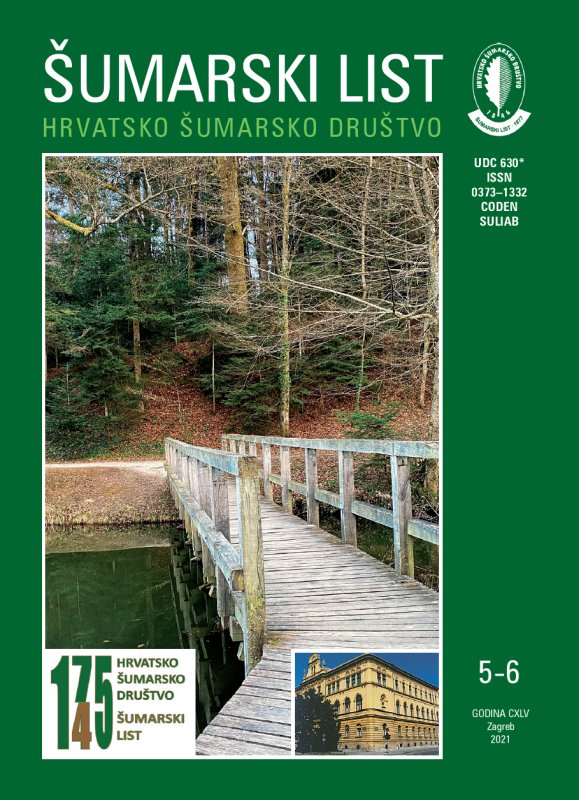
broj: 5-6/2021
pdf (15,7 MB) |
|
||||||||||||||
| RIJEČ UREDNIŠTVA | ||
| Uredništvo | ||
| The demise of a man who has devoted his life to forests and forestry pdf HR EN | 209 | |
| IZVORNI ZNANSTVENI ČLANCI | ||
| Tomislav Poršinsky, Vitomir Kajgana, Željko Tomašić, Andreja Đuka | UDK 630* 453 (001) https://doi.org/10.31298/sl.145.5-6.1 | |
| Gradeability of the cable skidder based on traction performance pdf HR EN | 211 | |
| Krunoslav Sever, Dimitrije Damir Sviličić, Tomislav Karažija, Boris Lazarević, Željko Škvorc | UDK 630*232.3 (001) https://doi.org/10.31298/sl.145.5-6.2 | |
| Photosynthetic response of common beech seedlings to suboptimal mineral nutrition pdf HR EN | 225 | |
| Ahmet Lojo, Jusuf Musić, Besim Balić, Admir Avdagić, Velid Halilović, Aida Ibrahimspahić, Jelena Knežević | UDK 630* 523 (001) https://doi.org/10.31298/sl.145.5-6.3 | |
| Modeling bark thickness of beech (Fagus sylvatica L.) pdf HR EN | 239 | |
| Tark Çtgez, Refik Karagül, Mehmet Özcan | UDK 630*114.1 + 116 https://doi.org/10.31298/sl.145.5-6.4 | |
| Evaluation of the effects of some watershed characteristics on water and suspended sediment yield in agricultural and forest dominated watersheds pdf HR EN | 249 | |
| PRETHODNO PRIOPĆENJE | ||
| Nediljko Landeka, Mirela Uzelac, Danijela Poljuha, Barbara Sladonja | UDK 630* 453 https://doi.org/10.31298/sl.145.5-6.5 | |
| The first record of the asiatic string cottony scale Takahashia japonica in Croatia pdf HR EN | 263 | |
| Toni Safner, Ana Gracanin, Ivan Gligora, Boštjan Pokorny, Katarina Flajšman, Marco Apollonio, Nikica Šprem | UDK 630* 461 https://doi.org/10.31298/sl.145.5-6.6 | |
| State border fences as a threat to habitat connectivity: a case study from South-Eastern Europe pdf HR EN | 269 | |
| PREGLEDNI ČLANCI | ||
| Marina Milović, Marko Kebert, Saša Orlović | UDK 630* 172.8 https://doi.org/10.31298/sl.145.5-6.7 | |
| How mycorrhizas can help forests to cope with ongoing climate change? pdf HR EN | 279 | |
| Abstract The ongoing climate change have multi-faceted effects not only on metabolism of plants, but also on the soil properties and mycorrhizal fungal community. Under climate change the stability of the entire forest ecosystems and the carbon balance depend to a large degree on the interactions between trees and mycorrhizal fungi. The main drivers of climate change are CO2 enrichment, temperature rise, altered precipitation patterns, increased N deposition, soil acidification and pollutants, ecosystem fragmentation and habitat loss, and biotic invasion. These drivers can impact mycorrhizal community directly and indirectly. We discussed the influence of each driver on mycorrhizal community and outlined how mycorrhizas play an important role in the resilience and recovery of forest ecosystems under climate change, by mitigating detrimental effects of CO2 enrichment, temperature rise, drought, lack of nutrients, soil acidification, pollutants, pests, and diseases. Conservation of the overall biodiversity in forest ecosystems as well as providing the most favourable conditions for the development of mycorrhizae can contribute to increasing the resilience of forest ecosystems to climate change. Key words: mycorrhizal fungi; forest trees; colonisation; increase of CO2; drought | ||


